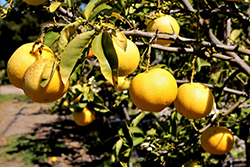It's all about ...
plants

Palestinian Sweet Lime
Citrus limettioides
Height: 8 feet
Spread: 8 feet
Sunlight:
![]()
![]()
Hardiness Zone: 9a
Other Names: Palestine Sweet Lime
Description:
This variety produces plentiful, greenish-yellow fruit that is very juicy, with exceptionally sweet flavor; mild, with low acid and few seeds, it is used widely as culinary seasoning, or as a refreshing drink; compact habit is great for home orchards
Edible Qualities
Palestinian Sweet Lime is a medium-sized shrub that is commonly grown for its edible qualities. It produces yellow fruit with chartreuse overtones which are typically harvested when mature. The fruits have a sweet taste and a juicy texture.
The fruit are most often used in the following ways:
- Cooking
- Juice-Making
- Seasoning
- Sauces
Features & Attributes
Palestinian Sweet Lime features showy clusters of fragrant white star-shaped flowers with yellow eyes at the ends of the branches from late winter to mid spring. It has attractive dark green foliage with grayish green undersides. The glossy pointy leaves are highly ornamental and remain dark green throughout the winter. It features an abundance of magnificent yellow berries with chartreuse overtones from mid summer to mid fall.
This is a multi-stemmed evergreen shrub with an upright spreading habit of growth. Its average texture blends into the landscape, but can be balanced by one or two finer or coarser trees or shrubs for an effective composition. This is a relatively low maintenance plant, and is best pruned in late winter once the threat of extreme cold has passed. It is a good choice for attracting birds, bees and butterflies to your yard. Gardeners should be aware of the following characteristic(s) that may warrant special consideration;
- Spiny
Aside from its primary use as an edible, Palestinian Sweet Lime is sutiable for the following landscape applications;
- Accent
- Hedges/Screening
- Orchard/Edible Landscaping
- Container Planting
Planting & Growing
Palestinian Sweet Lime will grow to be about 8 feet tall at maturity, with a spread of 8 feet. It has a low canopy with a typical clearance of 1 foot from the ground, and is suitable for planting under power lines. It grows at a medium rate, and under ideal conditions can be expected to live for 50 years or more. This is a self-pollinating variety, so it doesn't require a second plant nearby to set fruit.
This shrub is typically grown in a designated area of the yard because of its mature size and spread. It does best in full sun to partial shade. It does best in average to evenly moist conditions, but will not tolerate standing water. This plant should be periodically fertilized throughout the active growing season with a specially-formulated acidic fertilizer. It is not particular as to soil type, but has a definite preference for acidic soils, and is subject to chlorosis (yellowing) of the foliage in alkaline soils. It is somewhat tolerant of urban pollution. This species is not originally from North America.
Palestinian Sweet Lime is a good choice for the edible garden, but it is also well-suited for use in outdoor pots and containers. With its upright habit of growth, it is best suited for use as a 'thriller' in the 'spiller-thriller-filler' container combination; plant it near the center of the pot, surrounded by smaller plants and those that spill over the edges. It is even sizeable enough that it can be grown alone in a suitable container. Note that when grown in a container, it may not perform exactly as indicated on the tag - this is to be expected. Also note that when growing plants in outdoor containers and baskets, they may require more frequent waterings than they would in the yard or garden. Be aware that in our climate, most plants cannot be expected to survive the winter if left in containers outdoors, and this plant is no exception. Contact our experts for more information on how to protect it over the winter months.
This plant is not reliably hardy in our region, and certain restrictions may apply; contact the store for more information.
